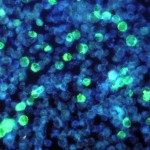Link to Pubmed [PMID] – 30953434
Microbiol Spectr 2019 03;7(2)
Human immune system (HIS) mice are created by transplanting human immune cells or their progenitor cells into highly immunodeficient recipient mouse hosts, thereby “humanizing” their immune systems. Over past decades, the field of HIS mice has evolved rapidly, as modifications of existing immunodeficient mouse strains have been developed, resulting in increasing levels of human tissue engraftment as humanization is optimized. Current HIS mouse models not only permit elevated levels of human cell engraftment but also demonstrate graft stability. As such, HIS mice are being extensively used to study the human innate and adaptive immune response against microbial infections . Compared to nonhumanized animal models, which are frequently infected with surrogate or adapted microbes, the HIS mouse models allow the analysis of interactions between human immune cells and pathogenic microbes, making them a more clinically relevant model. This article reviews the development of HIS mice and covers the different strategies used to humanize mice, as well as discussing the use of HIS mice for studying bacterial infections that cause human disease.


